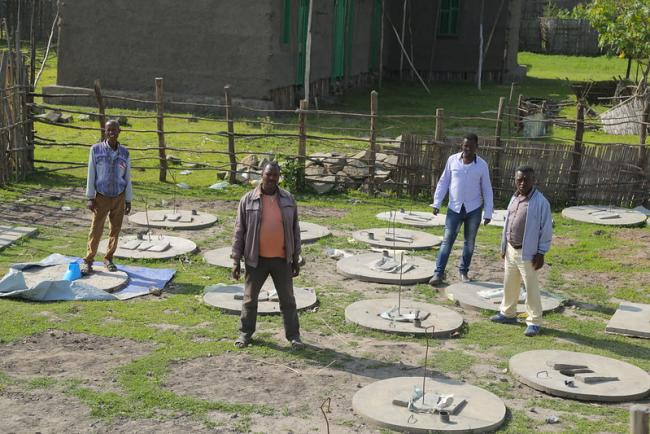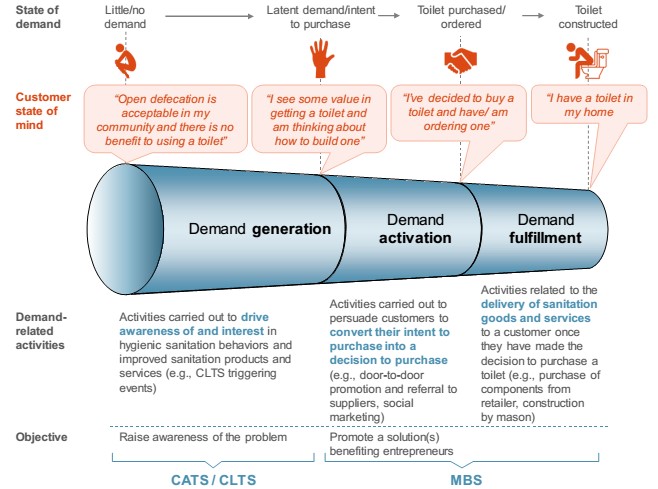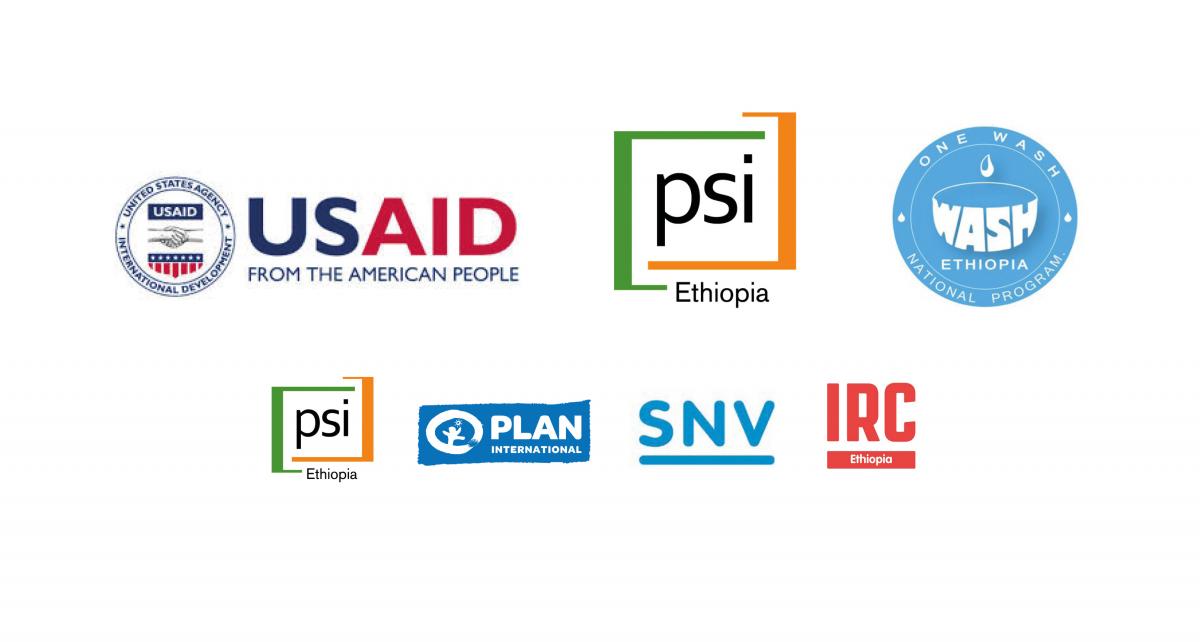How combining Community-Led Total Sanitation (CLTS) and market-based approaches can help.
Published on: 12/11/2019
Blog by Ambrose Kibuuka and Peter Feldman.

USAID Transform WASH Programme: Latrine slab construction in Shashego woreda, SNNPR, Ethiopia. Photo: IRC
Recognising the importance of hygienically managing faecal matter to individual and community health as well as to pride and dignity, the 2030 Sustainable Development Goal (SDG) target 6.2 aims to “achieve access to adequate and equitable sanitation and hygiene for all, and end open defecation.” This represents a broadened focus for the WASH sector, especially for rural areas, beyond infrastructure (e.g. installation of any type of toilet) and campaigns to end open defecation. There has been considerably less focus on getting people to install or upgrade to toilets which effectively separate faecal matter from the environment, and to ensure that behaviour changes are sustained.
According to the WHO-UNICEF “Joint Monitoring Programme”, as of 2017 around one third of the global population still lacked access to 'basic' sanitation facilities, and 40% lacked access to basic hygiene (e.g., handwashing) facilities. Most of the unserved population live in rural areas. With 11 years remaining, only 12 countries are on track to achieve universal access to basic sanitation by 2030 (with over 90 developing countries being ‘off track’). So, at the current rate of progress, the SDG 6.2 target will not be achieved.
The best-known approaches for addressing the sanitation situation in rural areas are Community-Led Total Sanitation (CLTS) and sanitation marketing (also known as market-based sanitation). Each approach has strong proponents, but there has been a tendency to implement them independently, and some concern that they are incompatible with one another. However, there is increasing evidence not only that these two approaches are compatible, but that they are mutually reinforcing and complementary. While CLTS aims at raising awareness of the risks of open defecation and stimulating community (and wider) drives to reach ‘open defecation free’ status, sanitation marketing aims at establishing an effective supply of affordable and desirable toilet products and services and activating consumer demand to purchase them (Figure 1).

Figure 1: Phases of customer demand. The sequencing of the approaches and activities may differ in practice (Source: USAID, 2018b, 27)
In practice, key challenges for CLTS have been to sustain the behaviour change that ends open defecation, and to move households ‘up the sanitation ladder’ (i.e., from unhygienic types of toilets to ‘basic’ facilities and services that separate faecal matter from the environment). For sanitation marketing, a key challenge has been to expand from project-based achievements to reach widespread and sustainable scale.
Evidence and experience are now suggesting that a combination of these two approaches may prove more effective in moving households up the sanitation ladder and sustaining their behaviour change. This will require a greater degree of project and programme coordination at both national and local levels, as well as changes in the ‘enabling environment’ (e.g., government policies and regulations) that will encourage such coordination, as well as to strengthen the growth of a sustainable private sanitation sector marketplace. Other challenges, such as taxation and import duties, and access to credit for businesses as well as for households, also will need to be addressed. In addition, reaching the ‘last mile’ households may require some type of external financial support (e.g., subsidies or rebates). And reaching scale for these coordinated interventions will require sufficient human resources – i.e., well-trained persons and businesses capable of taking on the range of challenging tasks, from carrying out community-level behaviour change campaigns, private entrepreneurs who can produce and market affordable and appealing sanitation products, and government agency professionals who are capable of monitoring progress, updating policies and regulations, and mobilising needed resources. Also development assistance organisations will likely need to adapt their approaches to programme design, implementation, and integration.
There are already some good examples of how combining CLTS and market-based approaches can help achieve the desired impact. These include: Total Sanitation and Sanitation Marketing (TSSM) in Indonesia and Tanzania implemented by the Indonesian and Tanzanian governments respectively with funding from the Bill and Melinda Gates Foundation (BMGF) through the Water and Sanitation Program (WSP); BRAC WASH programme in Bangladesh; Hands-Off Sanitation Marketing (HSM) in Cambodia by WaterSHED Asia; and Sanitation Marketing Scale Up (SMSU) in Cambodia by iDE Cambodia.
In Ethiopia, IRC is involved in the USAID Transform WASH programme where government-employed Health Extension Workers (HEWs) and sales agents both play a role in raising public awareness of locally available sanitation products and services. The programme recommends that sanitation marketing approaches are formally integrated into Ethiopia's Health Extension Programme. The USAID Transform WASH programme is implemented by PSI in collaboration with SNV, Plan International, and IRC.
Research on the effectiveness of combining behaviour change with market-based approaches, sharing of the lessons learnt (see for example, UNC, 2017; USAID, 2018a; USAID, 2018b) for implementation of these programmes, and adapting new ones based on current evidence are required for a concerted effort to achieve SDG 6.2. IRC can play a role in facilitating the sector learning.
About Transform WASH
USAID TRANSFORM WASH sets out to improve water, sanitation and hygiene (WASH) outcomes in Ethiopia by increasing access to and sustained use of a wide spectrum of affordable WASH products and services, with a focus on sanitation. It does so by transforming the market for low-cost, high quality WASH products and services: stimulating demand at community level, strengthening supply chains, and building the enabling environment for a vibrant private market.
USAID TRANSFORM WASH is a USAID-funded project implemented by PSI in collaboration with SNV, Plan International, and IRC. The consortium is working closely with government agencies including the Ministry of Health, the Ministry of Water, Irrigation and Electricity, the National WASH Coordination Office and regional governments.
Sources
UNC, 2017. Review of rural sanitation approaches : final report. Chapel Hill, NC, USA: The Water Institute at UNC. [More information]
USAID, 2018a. An examination of CLTS’s contributions toward universal sanitation. Washington, DC, USA: USAID Water, Sanitation, and Hygiene Partnerships and Sustainability (WASHPaLS) Project. [More information
USAID, 2018b. Scaling market based sanitation : desk review on market-based rural sanitation development programs. Washington, DC, USA: USAID Water, Sanitation, and Hygiene Partnerships and Learning for Sustainability (WASHPaLS) Project. [More information]

At IRC we have strong opinions and we value honest and frank discussion, so you won't be surprised to hear that not all the opinions on this site represent our official policy.